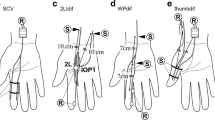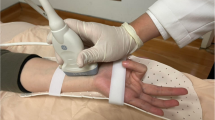Abstract
Sensory nerve conduction velocities in the palm-to-finger (SCV-pf), wrist-to-finger (SCV-wf), wrist-to-palm (SCV-wp), and wrist-to-elbow (SCV-we) segments and the distribution of nerve conduction velocities in the right median nerve were determined among 27 female operators aged 19–37 and 19 healthy women (controls) aged 19-31 to estimate the prevalence of subclinical carpal tunnel syndrome (CTS). Also, the WF/PF ratio, dividing the SCV-wf by the SCV-pf, was calculated to assess abnormalities of nerve conduction within the carpal tunnel. The operators were engaged in data entry in front of a visual display terminal (VDT) for about 6 h/day, and their working duration was between 1 and 17 (mean 6) years. The SCV-wf, SCV-wp, and WF/PF ratio in the operators were significantly lower than those in the controls. The rate of persons with the WF/PF ratio of less than 90%, i.e., below normal limits in the 19 controls, was significantly higher in the operator group (37%) than in the control group (0%). The operators complained of more symptoms related to CTS than did the controls, but any symptoms were not associated with slowing of nerve conduction velocities in the operators. In the controls, the WF/PF ratio was not closely correlated with skin temperature or age despite the presence of significant relations between skin temperature and the SCV-wf, SCV-pf, and SCV-wp; the interpersonal variability of the WF/PF ratio was much smaller than that of all SCVs. In the light of the present and previous studies, the rate of VDT operators with subclinical CTS seems to be high, independent of its symptoms. Also, the WF/PF ratio will be a useful and reliable screening method for the early detection of CTS due to repetitive wrist and finger movements involved in work.
Similar content being viewed by others
References
Araki S, Yokoyama K, Murata K, Aono H (1986) Determination of the distribution of conduction velocities in workers exposed to lead, zinc and copper. Br J Ind Med 43:321–326
Araki S, Yokoyama K, Aono H, Murata K (1988) Determination of the distribution of nerve conduction velocities in chain saw operators. Br J Ind Med 45:341–344
Armstrong TJ, Chaffin DB (1979) Carpal tunnel syndrome and selected personal attributes. J Occup Med 21:481–486
Armstrong TJ, Castelli WA, Evans FG, Diaz-Perez R (1984) Some histological changes in carpal tunnel contents and their biomechanical implications. J Occup Med 26:197–201
Barker AT, Brown BH, Freeston H (1979) Determination of the distribution of conduction velocities in human nerve trunks. IEEE Transact Biomed Eng 26:76–81
Bleecker ML, Bohlman M, Moreland R, Tipton A (1985) Carpal tunnel syndrome: role of carpal canal size. Neurology 35:1599–1604
Buchthal F, Rosenfalck A (1971) Sensory conduction from digit to palm and from palm to wrist in the carpal tunnel syndrome. J Neurol Neurosurg Psychiatry 34:243–252
Buchthal F, Rosenfalck A, Trojaborg W (1974) Electrophysiological findings in entrapment of the median nerve at wrist and elbow. J Neurol Neurosurg Psychiatry 37:340–360
Cannon LJ, Bernacki EJ, Walter SD (1981) Personal and occupational factors associated with carpal tunnel syndrome. J Occup Med 23:255–258
Dekel S, Papaioannou T, Rushworth G, Coates R (1980) Idiopathic carpal tunnel syndrome caused by carpal stenosis. Br Med J 280:1297–1299
Faucett J, Rempel D (1994) VDT-related musculoskeletal symptoms: interactions between work posture and psychosocial work factors. Am J Ind Med 26:597–612
Gelmers HJ (1979) The significance of Tinel's sign in the diagnosis of carpal tunnel syndrome. Acta Neurochir 49:255–258
Gerr F, Letz R, Landrigan PJ (1991) Upper-extremity musculoskeletal disorders of occupational origin. Ann Rev Public Health 12:543–566
Goadsby RJ, Burke D (1994) Deficits in the function of small and large afferent fibers in confirmed cases of carpal tunnel syndrome. Muscle Nerve 17:614–622
Jetzer TC (1991) Use of vibration testing in the early evaluation of workers with carpal tunnel syndrome. J Occup Med 33:117–120
Kimura J (1978) A method for determining median nerve conduction velocity across the carpal tunnel. J Neurol Sci 38:1–10
Kimura J (1979) The carpal tunnel syndrome: localization of conduction abnormalities within the distal segment of the median nerve. Brain 102:619–635
Kirmura J (1989) Electrodiagnosis in diseases of nerve and muscle: principles and practice, 2nd edn. F.A. Davis, Philadelphia
Koskimies K, Färkkilä M, Pyykkö I, Jäntti V, Aatola S, Starck J, Inaba R (1990) Carpal tunnel syndrome in vibration disease. Br J Ind Med 47:411–416
Margolis W, Kraus JF (1987) The prevalence of carpal tunnel syndrome symptoms in female supermarket checkers. J Occup Med 29:953–956
Mills KR (1985) Orthodromic sensory action potentials from palmar stimulation in the diagnosis of carpal tunnel syndrome. J Neurol Neurosurg Psychiatry 48:250–255
Murata K, Araki S (1985) Effects of age, height and skin temperature on latencies of short-latency somatosensory evoked potentials (in Japanese with English abstract). Jpn J EEG EMG 13:152–158
Murata K, Araki S, Aono H (1987) Assessment of central and peripheral nerve functions in chain-saw operators: a study of short-latency somatosensory evoked potential and peripheral nerve conduction. Tohoku J Exp Med 151:25–31
Murata K, Araki S, Kawakami N, Saito Y, Hino E (1991a) Central nervous system effects and visual fatigue in VDT workers. Int Arch Occup Environ Health 63:109–113
Murata K, Araki S, Maeda K (1991b) Autonomic and peripheral nervous system dysfunction in workers exposed to hand-arm vibration: a study of R-R interval variability and distribution of nerve conduction velocities. Int Arch Occup Environ Health 63:205–211
Nathan PA, Meadows KD, Doyle LS (1988) Occupation as a risk factor for impaired sensory conduction of the median nerve at the carpal tunnel. J Hand Surg 1313:167–170
Nathan PA, Keniston RC, Meadows KD, Lockwood RS (1993) Predictive value of nerve conduction measurements at the carpal tunnel. Muscle Nerve 16:1377–1382
Nathan PA, Takigawa K, Keniston RC, Meadows KD, Lockwood RS (1994) Slowing of sensory conduction of the median nerve and carpal tunnel syndrome in Japanese and American industrial workers. J Hand Surg 19B:30–34
Neary D, Ochoa J, Gilliatt RW (1975) Sub-clinical entrapment neuropathy in man. J Neurol Sci 24:283–298
Osorio AM, Ames RG, Jones J, Castorina J, Rempel D, Estrin W, Thompson D (1994) Carpal tunnel syndrome among grocery store workers. Am J Ind Med 25:229–245
Sakakibara H, Kondo T, Miyao M, Yamada S (1994) Digital nerve conduction velocity as a sensitive indication of peripheral neuropathy in vibration syndrome. Am J Ind Med 26:359–366
Silverstein BA, Fine LJ, Armstrong TJ (1987) Occupational factors and carpal tunnel syndrome. Am J Ind Med 11:343–358
Stock SR (1991) Workplace ergonomic factors and development of musculoskeletal disorders of the neck and upper limbs: a meta-analysis. Am J Ind Med 19:87–107
Thomas PK, Fullerton PM (1963) Nerve fibre size in the carpal tunnel syndrome. J Neurol Neurosurg Psychiatry 26:520–527
Uncini A, Di Muzio A, Awad J, Manente G, Tafuro M, Gambi D (1993) Sensitivity of three median-to-ulnar comparative tests in diagnosis of mild carpal tunnel syndrome. Muscle Nerve 16:1366–1373
Winn FJ Jr, Habes DJ (1990) Carpal tunnel area as a risk factor for carpal tunnel syndrome. Muscle Nerve 13:254–258
Author information
Authors and Affiliations
Rights and permissions
About this article
Cite this article
Murata, K., Araki, S., Okajima, F. et al. Subclinical impairment in the median nerve across the carpal tunnel among female VDT operators. Int. Arch Occup Environ Heath 68, 75–79 (1996). https://doi.org/10.1007/BF00381238
Received:
Accepted:
Issue Date:
DOI: https://doi.org/10.1007/BF00381238




